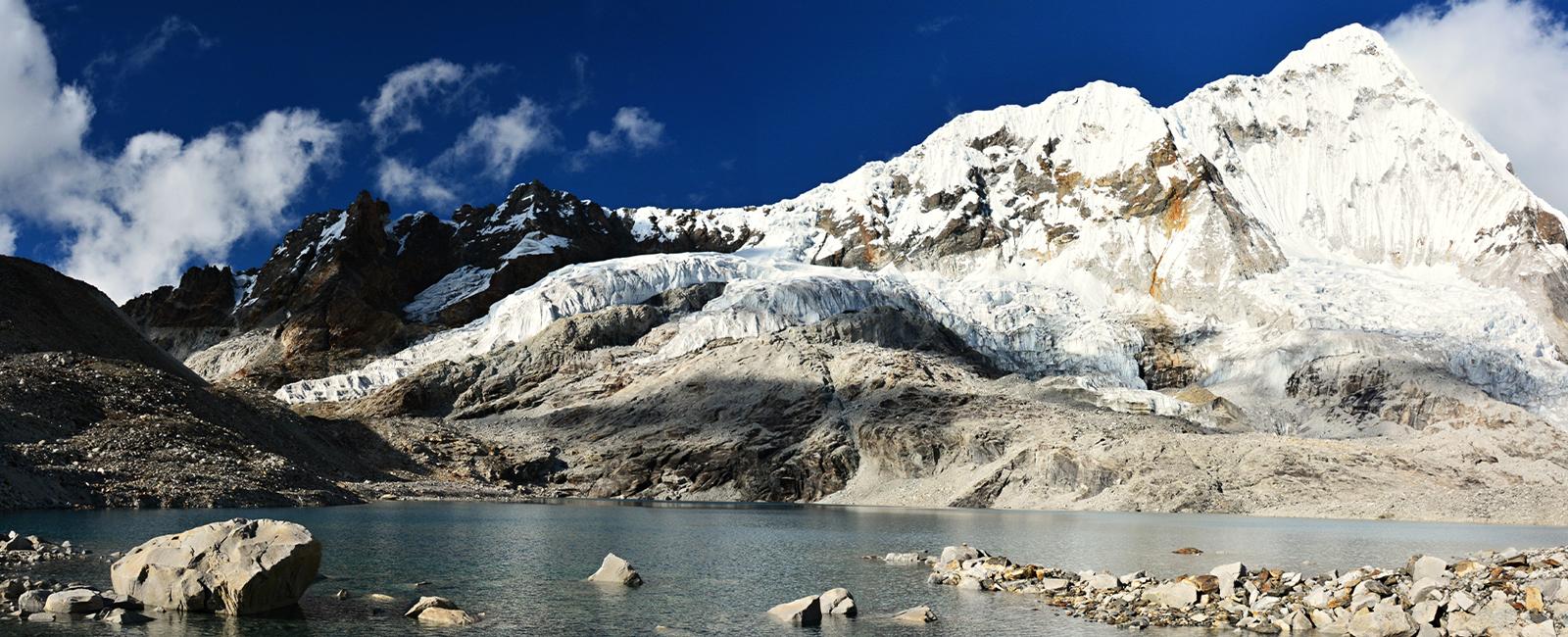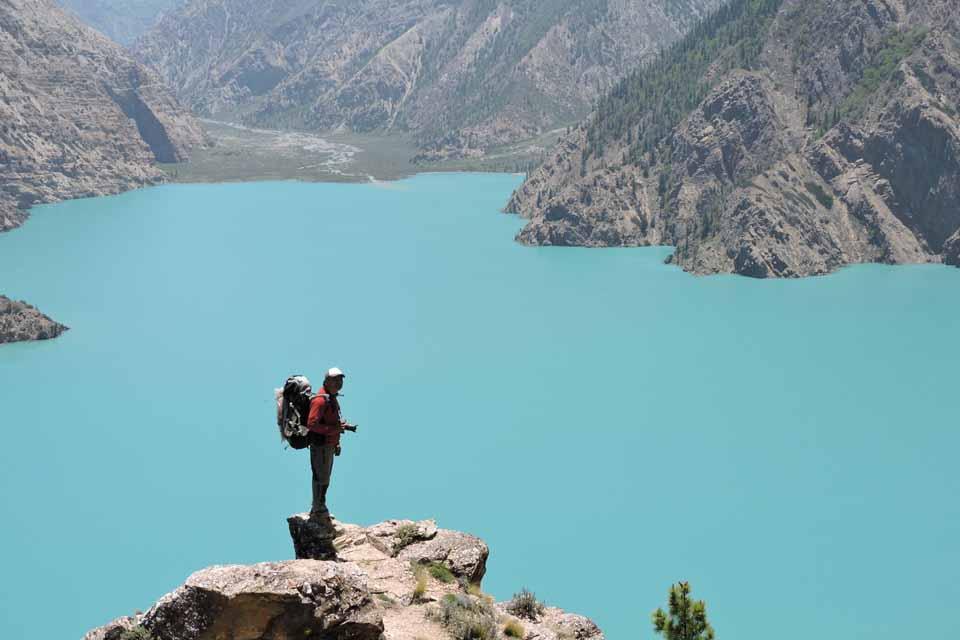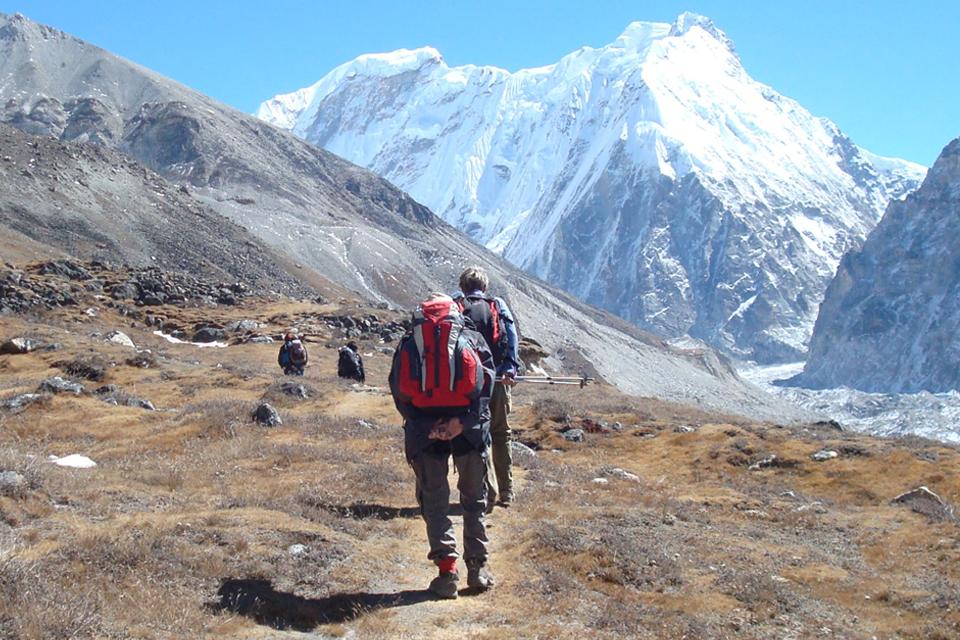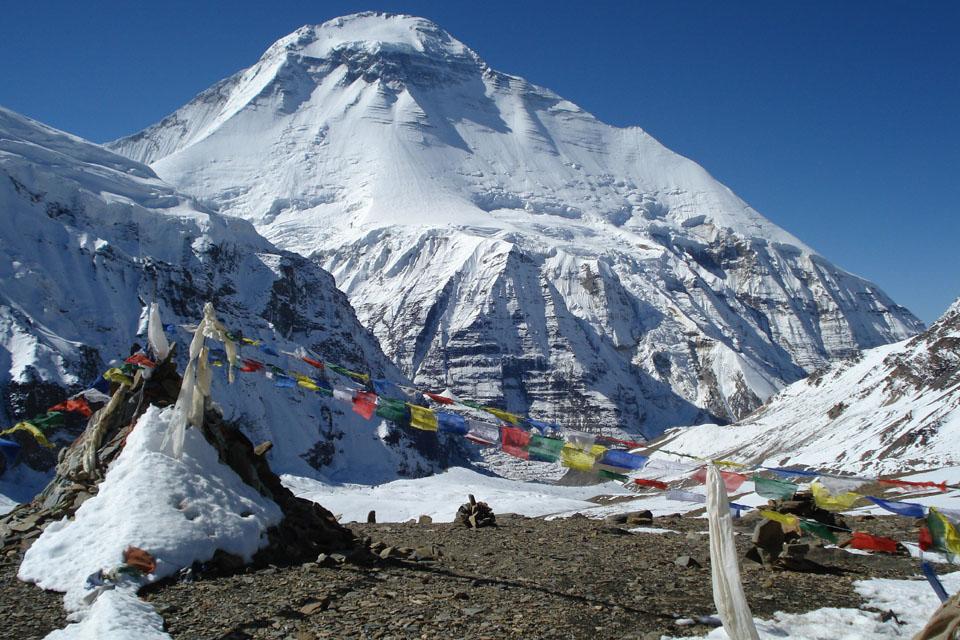Makalu Base Camp Trek
Trip at a Glance
Makalu Base Camp Trek is the off-beaten-path trek in the Himalayas located in the Makalu-Barun National Park of Nepal. Mount Makalu is the fifth-highest mountain in the world at 8485 meters, where the trek will take you to it’s base camp at 4870 meters. So you can imagine yourself how the trek is going to treat you to a unique adventure in the high Himalayas.
Standing at the base camp of Makalu, you will witness a grand panorama of several of the world’s highest peaks, like Mount Everest, Lhotse, Mount Makalu, and many others. Makalu base camp trek itinerary passes along diverse landscapes, lush forests, remote valleys, and high mountain passes.
Trekking to Makalu Base Camp starts after a scenic flight to Tumlingtar from Kathmandu to a small village of Num. Following Num, you will trek along many remote settlements like Seduwa, Tashigaon, and Khongma, which gives you an authentic experience of the culture and traditions of the locals unchanged for ages. You will cross over dense rhododendron and bamboo forests, making it a refreshing and pleasant walk.
The landscapes then dramatically begin to change as you gain altitude where you enter an alpine zone, making way for more rocky terrain with sparse vegetation. The climax unfolds as you reach the Makalu Base Camp at the foot of Mount Makalu, which provides a spectacular Himalayan panorama of some of the world’s highest peaks.
Makalu Base Camp Trek is a challenging trek and a great option for anyone seeking a remote and less crowded trekking experience in the Himalayas that offers stunning mountain views and a sense of adventure.
Why Choose the Makalu Base Camp Trek?
The Makalu Base Camp Trek offers an amazing trip by natural panoramas, beautiful forests, and high-altitude terrain. Unlike other popular treks in Nepal, such as the Everest Base Camp or Annapurna Circuit, this trek will not be as packed, which makes it perfect for trekkers who love peace and adventure.
Best Time for the Makalu Base Camp Trek
The best time to trek to Makalu Base Camp Trekking is:
Spring (March to May) ?
- Best weather and clear skies
- Blooming rhododendron forests
Autumn (September to November) ?
- Stable weather with clear mountain views
- Ideal for trekking and photography
Winter (December to February) ❄
- Cold and snowy, but possible for experienced trekkers
Monsoon (June to August) ☔
- Heavy rainfall and difficult trails (not recommended)
Packing List for the Makalu Base Camp Trek
Essential Gear
✔ Trekking boots ?
✔ Sleeping bag (-10°C to -20°C)
✔ Down jacket and warm layers
✔ Trekking poles
✔ Headlamp and extra batteries
Other Essentials
✔ Water purification tablets
✔ Sunscreen and sunglasses
✔ First aid kit
✔ High-energy snacks
Makalu Base Camp Trek Highlights
- Behold the Everest's eastern Kangshung face from a different angle
- Observe views of eastern Nepal with Kangchenjunga in the distance
- Hike from glaciers and waterfalls to verdant terraced farmland
- Witness the unique Rai and Sherpa cultures of Nepal's rural community
- Spot some of Nepal's rarest fauna, such as the Red Panda
Itinerary
Upon arrival at the Tribhuwan International Airport in Kathmandu, you will be received by a representative from Marron Treks and transferred to your designated hotel. Welcome drinks will be served at the hotel, and after that, we will have a quick pre-trip meeting to discuss the necessary formalities and the trekking itineraries. You may then check into your room and freshen up. In the evening, you can stroll around the vicinity of your hotel to get a superficial glimpse of this great city. Of course, you will know Kathmandu better when you head out for a sightseeing tour tomorrow.
From Kathmandu, we will take a flight to Tumlingtar. Enjoy the stunning aerial picture of the snow-covered mountains. We can see glacier-covered peaks including Mt. Kanchenjunga, Makalu, and Ganesh Himal. As soon as you arrive in Tumlingtar, we start our journey to Num village through Khandbari and Hururu.
We'll be moving along an uphill and downhill trail. To reach the Arun River, descend a broad and precipitous trail that has steep stone slopes. Enjoy the stunning countryside scenery as you go. Walk across the suspension bridge, over the Arun River, and down a winding trail before continuing on an elevation trail to Seduwa. Along the way, we'll see massive bamboo trees, villages in the city, traditional dwellings, and tea houses strewn across the mountain. As Makalu Barun National Park will also be on our itinerary, there is a checkpoint where the permits must be recorded.
The walk will be simpler and more undulating than it was yesterday. We shall ascend stone stairs after passing multiple Mani walls. In addition, as we travel, we will pass through woodlands with rhododendrons and bamboo. While strolling in a dense forest, one can hear the sounds of chattering birds. The woodland is home to a variety of birds, including cuckoos, singing thrushes, and barbets. Pass past the little community of Chyaksa Danda to reach a bridge. We have a few stone steps to climb to get to Tashigaon.
We will start our walk by climbing a few stone stairs and crossing a bridge before setting out on a sloping track through a rhododendron woodland. The woodland is bright in the spring when rhododendrons bloom. After a beautiful trek through the forest, we will arrive in Dhara, where we will pause for lunch and refreshments. We will trek along a path that passes by a huge rock before arriving at Unshisa. We proceed to Khongma Danda by climbing stone steps through a rhododendron forest.
The trip to Dobate, where we will cross high passes while taking in a spectacular perspective, will be one of the trek's primary highlights. We will climb a trail flanked by rhododendron trees before reaching Khongma La, which is at an elevation of 3873m. After ascending Khongma La, we are greeted with a breathtaking view of majestic peaks like Makalu and Chamlang. We will trek up and along a ridge after briefly descending till we reach Ghungru La (Tutu La), which is located at 4055m. Shipton La is accessible after a climb through a stony, ascent-only path and is located at an elevation of 4220 meters.
We will come across mani walls with mantras and waving prayer flags as we travel through the passes. To reach the 4022m-high Kalo Pokhari Lake, we shall keep descending. Visitors to a holy lake during the Janai Purnima festival Continue climbing until you reach Keke La at 4152m, where you can see the snow-capped mountain ranges. Use a route that descends through a stunning valley to reach Dobate
On a descending track, take a stroll through a pine, rhododendron, redstart, and minivet forest. If it is snowing, we should exercise extra caution because the road in the forest descends rapidly toward the Barun River. Enjoy the view of the Chamlang and Tutse mountains, which are covered in snow. We trek up a hill on a route till we reach Themathang Kharka. On the way, we'll pass by a breathtaking waterfall. We will also go across a rocky trail and a wooden bridge before reaching Yangle Kharka. O
We will be strolling along the path, past a little monastery and a river. As you stroll through the forest, take in the breathtaking view of the jagged cliffs on the opposite side. Stunning views of the alpine peaks will also be visible. The stroll will be pleasant and quite level. Continue through the meadows of Yak Kharka, Jhak Kharka, and Merek before arriving at Lagmale Kharka. As we pass the Mani walls, observe prayer flags as they flutter in the air.
We will spend the day at Langmale Kharka acclimatizing. We can choose to laze around or hike to a far-off hill. To help you more effectively adjust to the increasing altitude, our guide may suggest the best walks.
We will be walking today to Makalu Base Camp, the base camp for the fifth-highest peak on Earth. Additionally, Makalu will be visible, with its intimidating face covered in icefalls, crevasses, jagged edges, and seracs. We'll be strolling along a path that includes multiple turns. Before reaching the Makalu Base Camp (4870 m), where Makalu dominates the skyline, the path continues to descend, and we pass a river. Here, we might see black-red stars, Tibetan snowcocks, hill pigeons, and other species.
The second day of acclimatization is today. We ascend quickly and explore the glaciers and lakes that are close by. Beyond the desolate Makalu Base Camp is the enormous Barun Glacier. From here, we can see Mount Lhotse and Everest as a whole, as well as the stunning Makalu region to the south. A trip to a 5,250-meter ridge northeast of the Shershong on Peak 3's lower slope marks the trek's more rewarding end. From this vantage point, we can view Lotshe Shar, Lotshe, and Everest in the northwest. Here, you may observe the expansive valleys and breathtaking mountain views.
We will take the same route today as we climb to Yangle Kharka. We descend and stroll through Shershong, Langmale Kharka, and Merek before reaching Yangle Kharka. We will also hike through a dense pine forest while taking in the stunning alpine panorama.
Take it easy as you stroll alongside the winding river to Themathang. We will travel along a path filled with rhododendron bushes and past a bridge covered with prayer flags before arriving at Themathang Kharka. If we advance through the landslide region with extra caution, we will reach a place with a narrow path. Enjoy a strenuous hike through a rhododendron forest while taking in the stunning mountain view. On steep terrain, we will hike through a valley and a wonderful, green forest before arriving in Dobate.
Enjoy breathtaking views of Mount Kanchenjunga as we trek to Khongma Danda. The route we took before will be followed, with high passes crossed. We will ascend to Keke La Pass and eventually return to Shipton La, also known as Tutu La Pass. As we continue our climb to the Hindu shrine of Sano Pokhari Danda, take in the breathtaking scenery along the way. We'll also visit Khongma La, which can be found thanks to a mani wall. After descending a few stone stairs, we will reach Khongma. We may see blood pheasants in Khongma as they move through the rhododendron shrubs and snow.
We will depart Makalu Barun National Park from Khongma Danda, make a U-turn, and return to Seduwa. We proceed down the stone steps, over the bridge, and through the dense forest on a jungle path. We'll cross several bridges. The woodland serves as a habitat for a variety of avian species, so we will likely hear birds singing while out on the stroll. Watch out for farms that are dispersed over the slope and cardamom plants. After passing the Mani walls, we descend some stone steps to reach Seduwa.
Start the day with a stroll through a busy village and sizable bamboo groves. We continue our journey on a meandering trail to the Arun River. We will be treated to a stunning view of rural Nepal once we have crossed the suspension bridge. We'll also be descending a river on a set of substantial stone steps. The path ascends and descends through a gorgeous woodland on its way to the town of Num. Drive toward Tumlingtar on Nepal's winding mountain roads for a lovely journey. We will see hillside towns and terrace farms in addition to the breathtaking scene of snow-capped mountains and green surroundings.
Take a local flight to Kathmandu from Tumlingtar. Enjoy the scenic views of the Himalayan landscape, which includes snow-capped mountain ranges and green hills, from the luxury of the aeroplane. After we arrive in Kathmandu, you will be dropped off at your accommodation. You may relax after a strenuous walk or experience Kathmandu, a bustling metropolis, by strolling around Thamel.
Today is a free day in Kathmandu, and you can explore the city on your own, or if you have missed anything, you can go for a more cultural tour or sightseeing around Kathmandu, like Bhaktapur or Nagarkot. You can also explore Thamel for your souvenir shopping.
In the evening, there is a farewell dinner at one of the authentic Nepali restaurants with a cultural show where Nepali cultural dances are performed with a Nepali dinner. Afterwards, back to the hotel.
The trip concludes, and our office representatives will take you to the international airport in Kathmandu to catch your onward flight to your next destination or fly back home. You need to be at least 3 hours before your flight time at the airport.
Thank you for visiting Nepal, and we hope your Himalayan holiday has come true. Have a safe flight back home!
If you plan to extend your holiday, then other travel activities like jungle safaris, rafting, mountain biking, bungee jumping, etc. are also on the list.
What is included?
- Airport pick-up and drop-off services
- Hotel accommodations in Kathmandu with breakfast as per itinerary
- Kathmandu/Tumlingtra/Kathmandu round-trip fares
- All trekking accommodations with breakfast, lunch, or dinner at local lodges on a twin-sharing basis.
- Experienced government-licensed English-speaking guide and porter (1 porter for two people), including their food, accommodation, salary, & insurance.
- All surface transfers by private vehicle
- Four seasonal sleeping bags (to be returned after trip completion) & Marron Trek duffel bags.
- A comprehensive medical kit will be carried by the trekking guide.
- Makalu Barun National Park permit, Makalu Special Permit, and TIMS (Trekkers' Information Management System)
- Farewell dinner with a live Nepalese cultural program
- All government and local taxes
What is not included?
- International airfare.
- Nepal entry visa fee: A visa can be obtained upon your arrival at the Tribhuwan International Airport in Kathmandu. (USD30 for 15 days)
- Lunch & dinner in Kathmandu or Pokhara
- Personal travel insurance
- Emergency rescue evacuation (to be covered by the client's travel insurance)
- Excess baggage charges (the luggage allowance for domestic airlines in Nepal is 20 kg).
- Other expenses of a personal nature (phone calls, laundry, battery recharge, extra porters, bottles of boiled water, showers, etc.)
- Bar bills, alcoholic drinks, & beverages
- Tips for guides and porters (tipping is expected).
Route Map
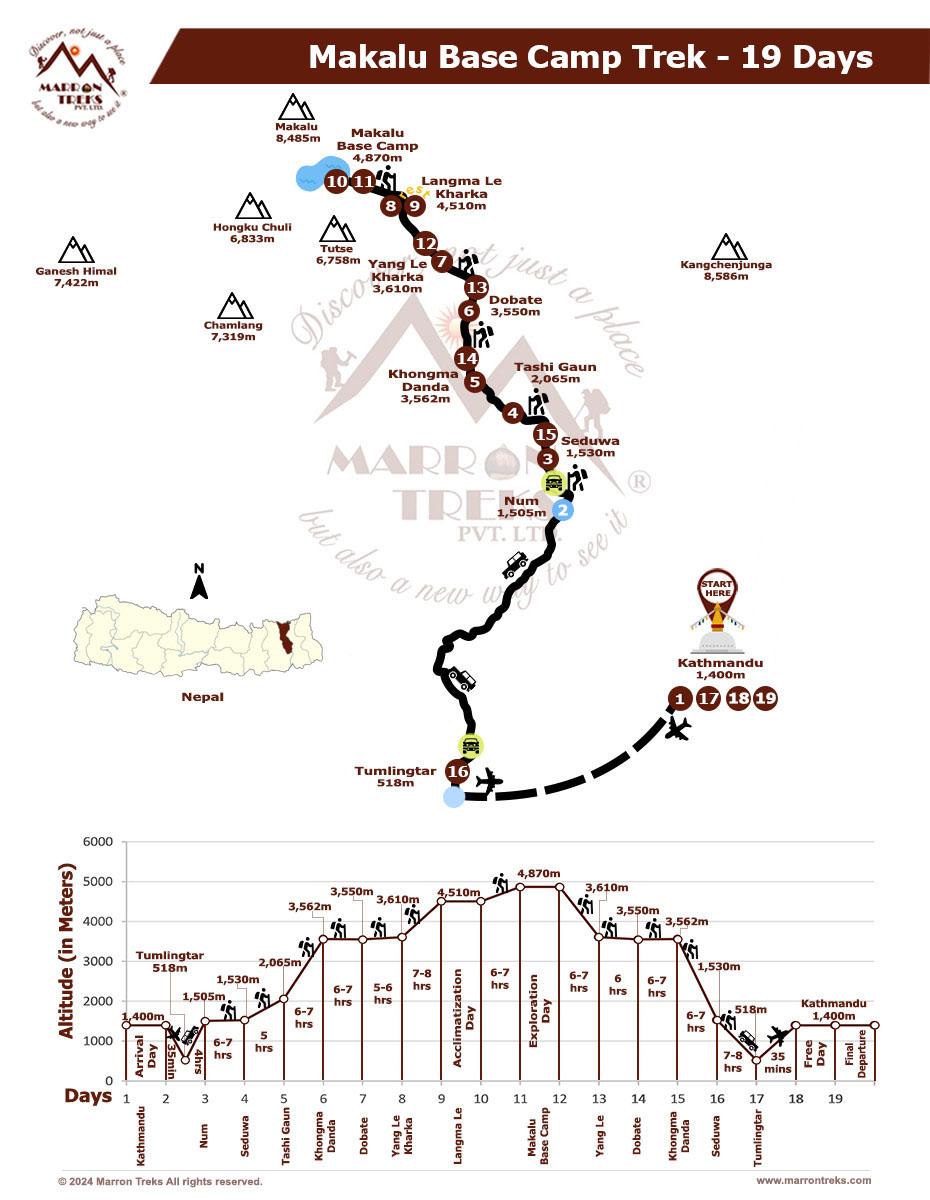
Trip Info
Acommodation
While you are in Kathmandu, we opt to accommodate you in 4- or 5-star hotels like Hotel Royal Singhi (4-star), Hotel Manaslu (4-star), Radisson (5-star), Yak & Yeti (5-star), or similar. During the trek, you will be accommodated in a local mountain lodge, better known as Tea House. These lodges and teahouses provide good services and are equipped with basic amenities. We will endeavor to provide you with the best accommodation available along the route so that you get a good night’s rest in a hygienic milieu.
Meals
We never compromise the quality of food or the health of the trekkers as well as the crew members. Generally, we opt for the fresh and nutritional local community food available. You could make your delicious pick from an array of traditional foods like sweet potatoes, buckwheat barley, etc. This way, you could not only get a real sense of the local culture and life patterns but also contribute to promoting the locally available resources of organic food and beverages. Besides, a wide range of Continental, Chinese, Italian, and Indian cuisines like pizza, spaghetti, French fries, soups, breads, masala curry, etc. are also available in the restaurants for your retreat.
Acclimatization
Altitude sickness is a serious risk while trekking in the Himalayas. It's important to acclimatize properly by spending a few days at lower altitudes before heading higher. By spending time at lower altitudes before pushing higher, your body has time to adjust. Our trekking packages have enough acclimatization days planned where you'll be spending a day or two at lower altitudes, allowing your body to adjust to the increasing altitude.
Electricity & drinking water
For an additional cost, you can use the electricity in all tea houses and lodges to recharge your batteries. The lodges have packaged mineral water for sale, or you can fill your bottle with boiling water. To make water drinkable, you can use water purification tablets too. But, due to hygienic issues, you should avoid drinking water from taps, rivers, or wells in trekking areas.
Communication
At lodges, restaurants, and hotels, Wi-Fi is available for an additional fee in the most popular trek regions, like Everest Trek and Annapurna Trek. However, at high elevations, phone calls are the only means of connection. Our office in Kathmandu is in constant communication with your trek guide. In Kathmandu, you can purchase a local SIM card for communication purposes. At high elevations, the mobile signal might not be as strong, though.
Luggage
Our porters are paired with one trekker for every two hikers, and one porter can safely carry 30 kg maximum weight. Therefore, we advise you to fill your duffle bag not more than 15 kg with your belongings. You may carry a small backpack with your valuables and informational documents. The things you are not taking along on the trek can be stored in a hotel in Kathmandu free of charge.
Typical Trek Day
Mostly your trek day starts with breakfast at 7-8 am, followed by a 3-4 hour morning trek. Lunch break is around an hour, then you continue trekking to your destination for the day. After reaching the teahouse lodge, you can relax, explore nearby areas, and enjoy dinner at 6-7 pm. Evenings involve socializing, a trek briefing, and leisure activities before bed.
Travel Insurance
It is advised that you arrange your travel insurance before leaving your homeland. The main thing is to make sure that your insurance covers you for both medical and evacuation costs. Having travel insurance with you makes your trip secure and hassle-free.
Our Guides
Guides play a significant role during the trek. They are the ones who literally decipher the trekking codes for you so that you can actually connect with nature, culture, and people along the way. We have helpful and dedicated trekking guides who are very well-versed in the culture, life patterns, and every single detail pertaining to the trek region you are traveling in. Thus, in the company of our professional Sherpa guides, your trek becomes not only entertaining but also equally informative.
Porter and Staff Care
When it comes to high-altitude trekking, porters and staff members make up a pivot. Marron Treks ensures that all the porters and staff members going to high altitudes are provided with adequate clothing and equipment. All our field staff are covered by insurance.

